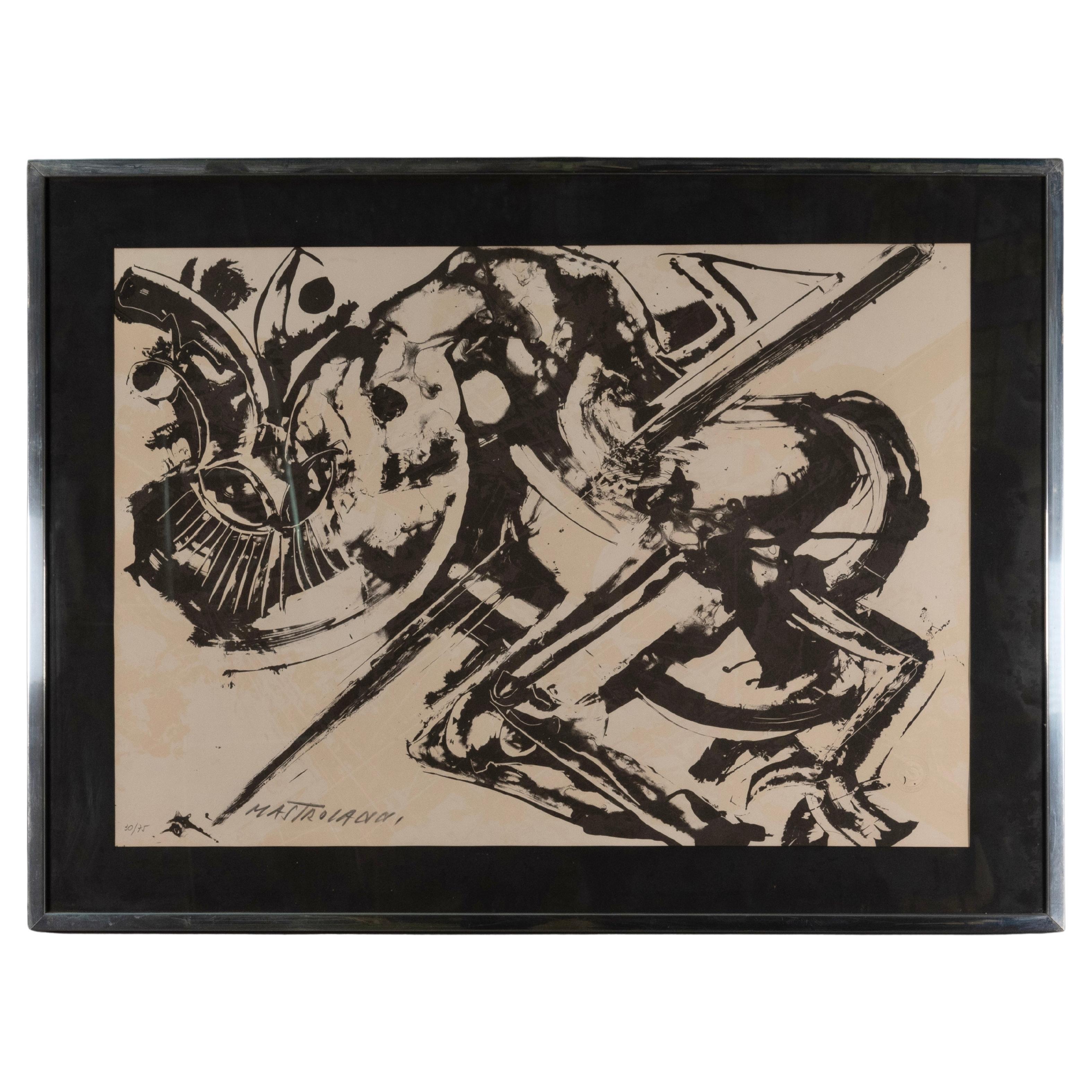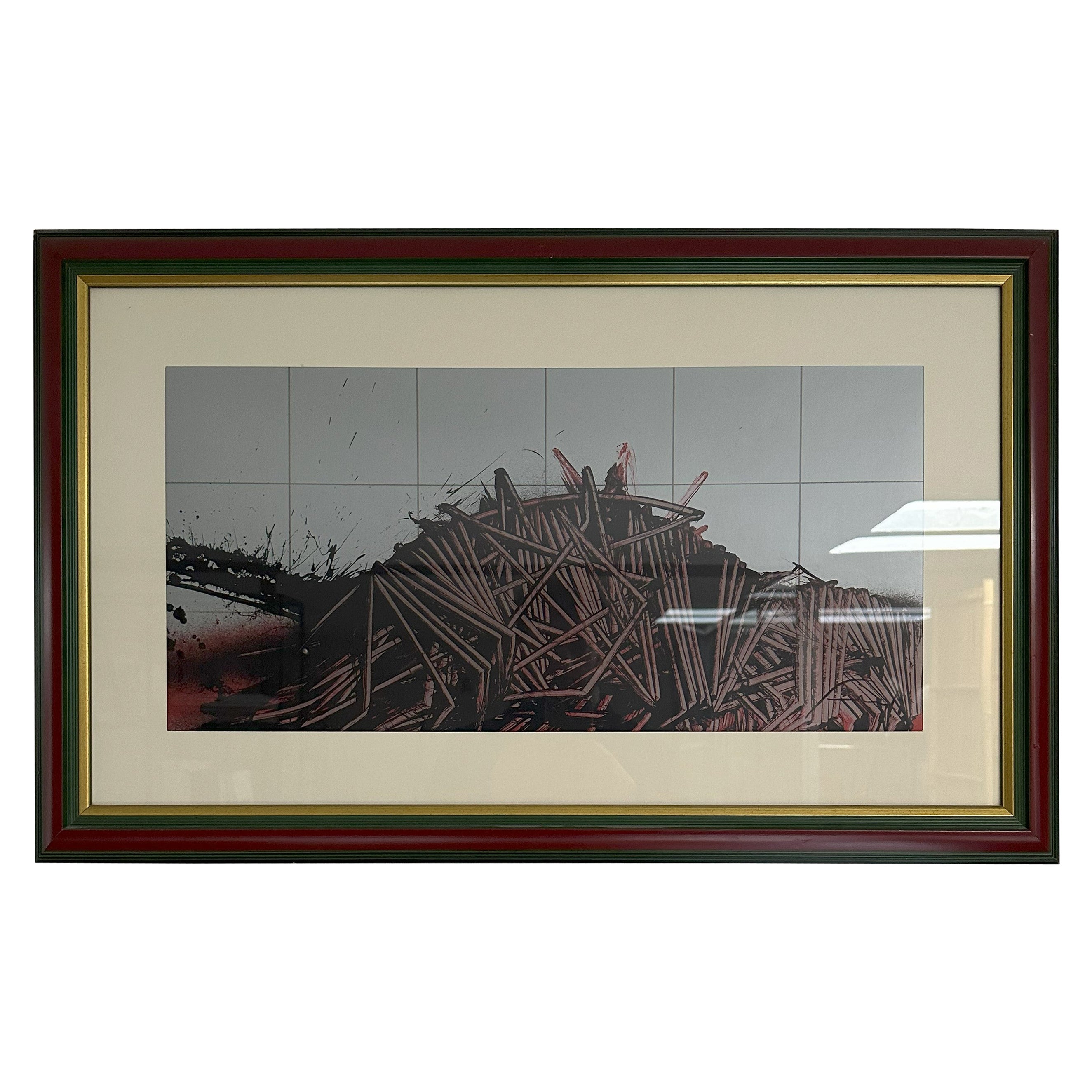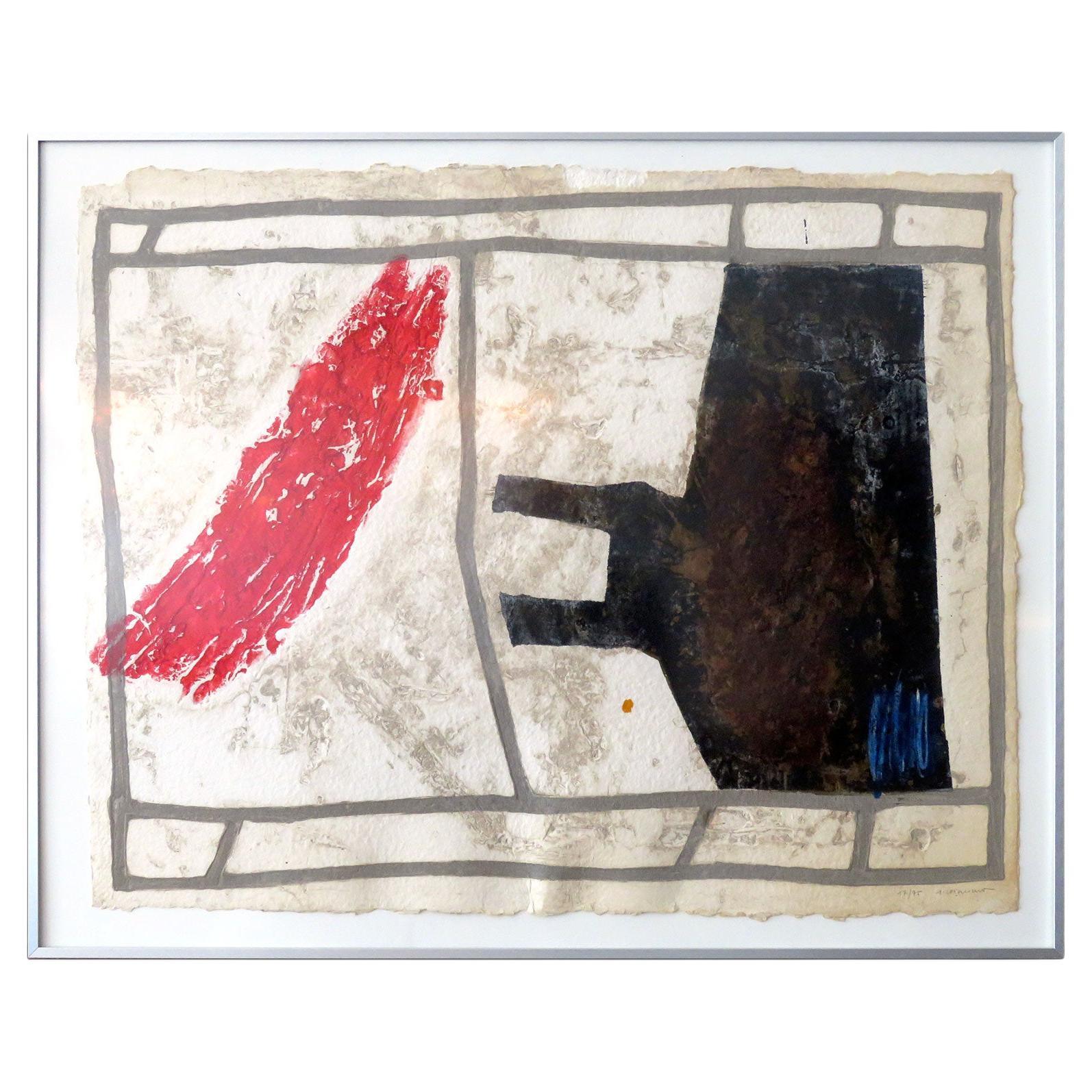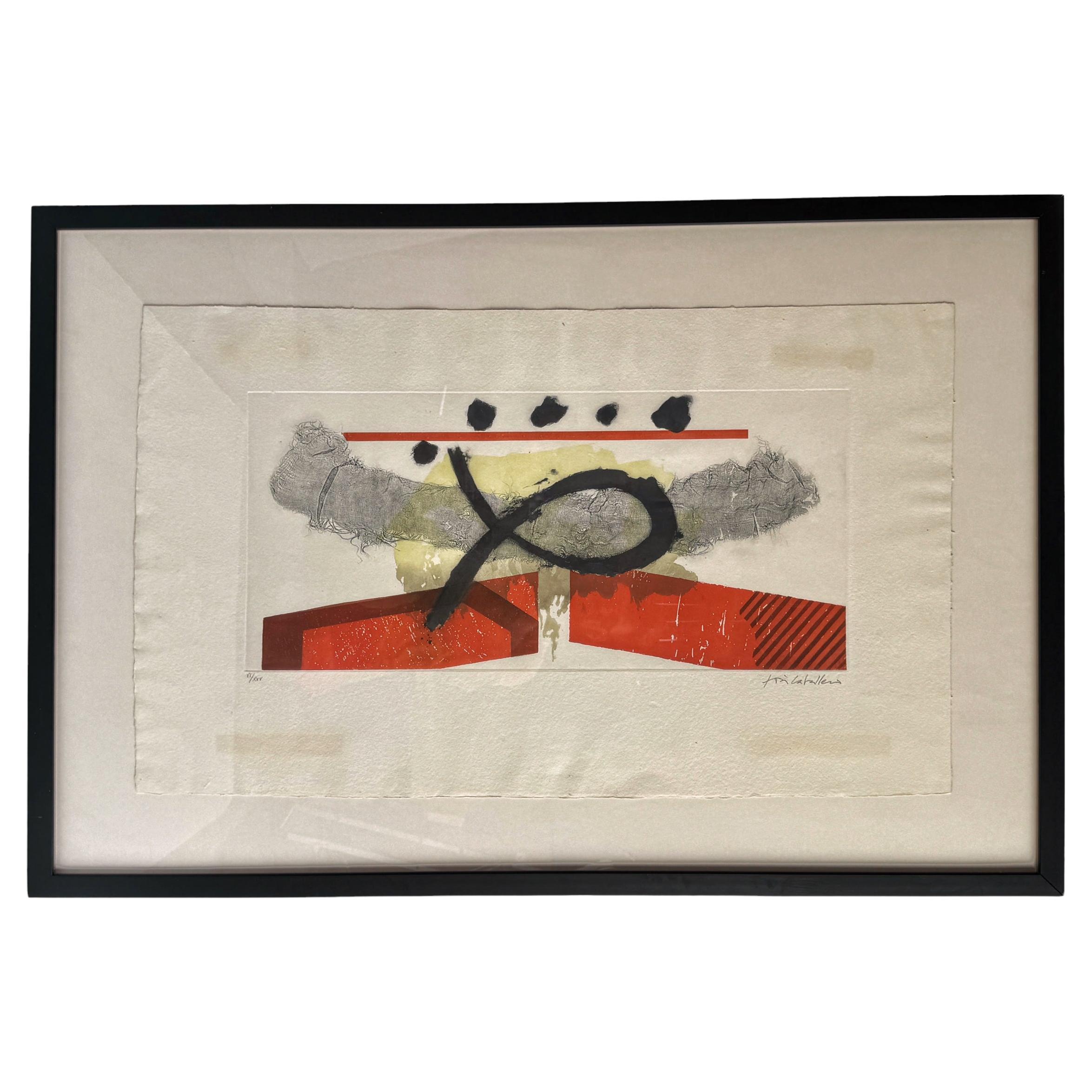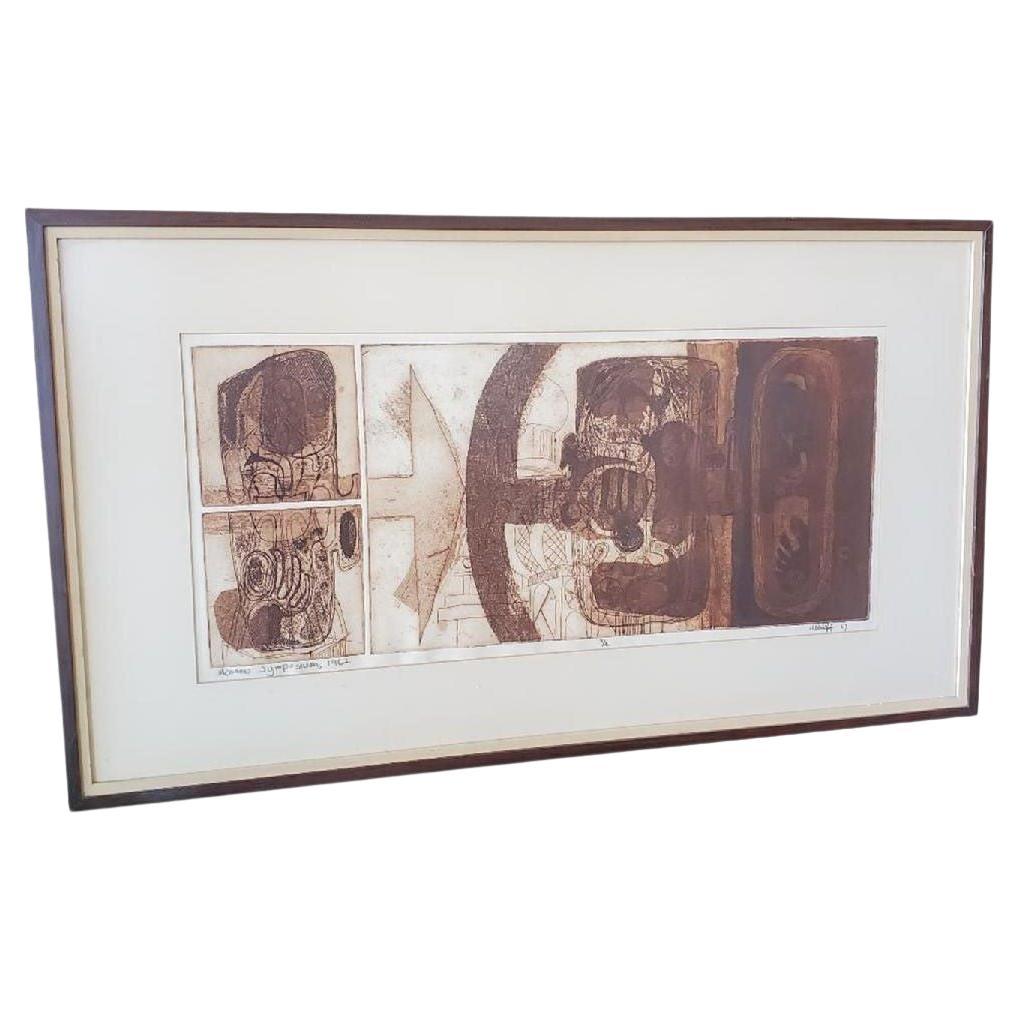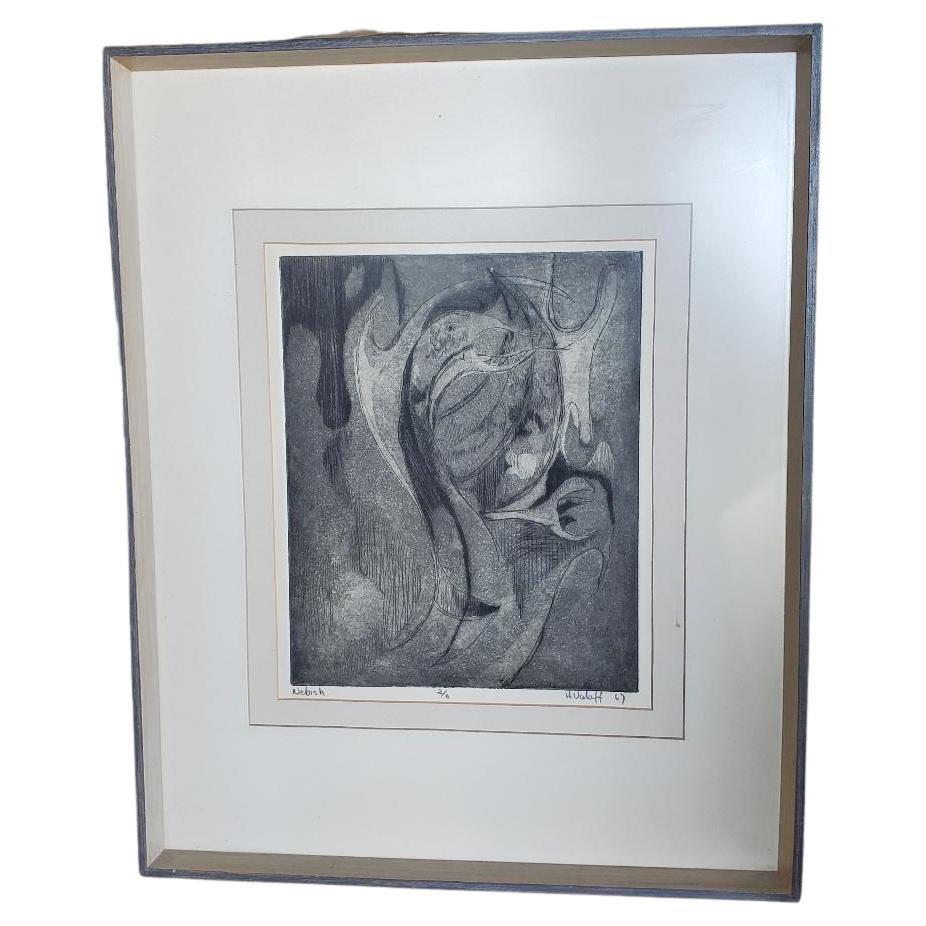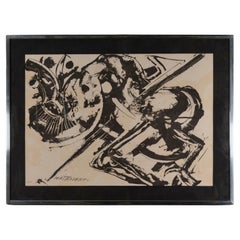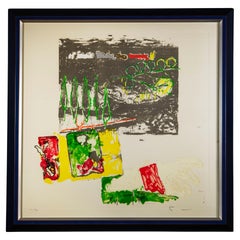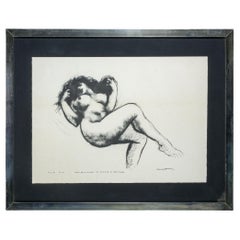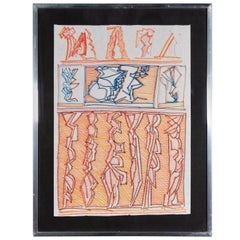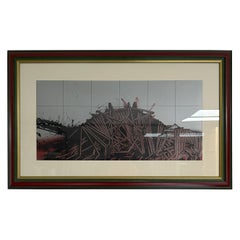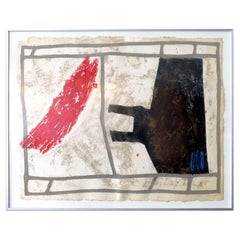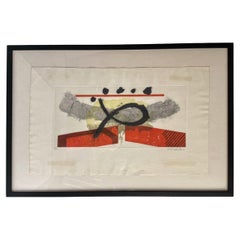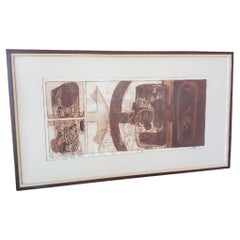Items Similar to Emilio Scanavino 1960s Original Silkscreen Signed and Numbered
Want more images or videos?
Request additional images or videos from the seller
1 of 11
Emilio Scanavino 1960s Original Silkscreen Signed and Numbered
$1,803.84
£1,312.99
€1,500
CA$2,455.21
A$2,746.30
CHF 1,429.19
MX$33,807.93
NOK 18,182.29
SEK 17,058.57
DKK 11,415.33
Shipping
Retrieving quote...The 1stDibs Promise:
Authenticity Guarantee,
Money-Back Guarantee,
24-Hour Cancellation
About the Item
Beautiful and important colour silkscreen by the great Italian artist Emilio Scanavino
This work best represents the artistic signature of one of the greatest artists of the 20th century artistic avant-garde.
Taking up one of his iconic features, this abstract motif represents a geometric composition with a circle
Title ‘The Welding of the Circle
Published in the book entitled ‘40 drawings by modern masters’.
Author of the publication: De Micheli Mario/ Fieschi Giannetto/ Zigaina Giuseppe/ Scanavino Emilio/ Gasparini Giansisto
Edition: SEDA/ Milan/ 1968
Page/table number: work no. 3
Period Conceived and realised between 1950 and 1968
This artwork, never before on the market, comes from a private collection and is beautified by an impressive original frame in almost perfect condition.
The etching is also protected by glass
Born in Genoa in 1922, in 1938 he enrolled at the Liceo Artistico Nicolò Barabino in Genoa[1], where he met Professor Mario Calonghi, a figure of great cultural stimulus for his early education. Four years later, he had his first solo exhibition at the Salone Romano in Genoa. In the same year, he enrolled in the Faculty of Architecture at the University of Milan.
After marrying Giorgina Graglia in 1946, he went to Paris for the first time in 1947 where he stayed for some time and met poets and artists such as Édouard Jaguer, Wols and Camille Bryen. The Parisian experience was to prove fundamental in his stylistic development, particularly for the echoes of post-Cubism, which he assimilated and interpreted in a personal key as early as 1948, when he exhibited at the Isola Gallery in Genoa.
In 1949, Sebastiano, the first of two children, was born. In 1950 he exhibited at the 25th Venice Biennale. The following year, on the occasion of a solo exhibition at the Apollinaire Gallery, he lived for some time in London, where he met and frequented Philip Martin, Eduardo Paolozzi, Graham Vivian Sutherland and Francis Bacon. In the same year, he opened his first studio in Milan in an attic in Foro Bonaparte. On these occasions Guido Ballo and the gallery owners Guido Le Noci and Arturo Schwarz took charge of his work.
The following year, 1952, he also worked in the Ceramiche Mazzotti factory in Albissola Marina, where he met numerous artists and became friends with some of them.
- Creator:Emilio Scanavino (Artist)
- Dimensions:Height: 13.78 in (35 cm)Width: 18.51 in (47 cm)Depth: 0.79 in (2 cm)
- Style:Mid-Century Modern (Of the Period)
- Materials and Techniques:
- Place of Origin:
- Period:
- Date of Manufacture:1960 ca.
- Condition:Wear consistent with age and use. Minor fading.
- Seller Location:Roma, IT
- Reference Number:1stDibs: LU4827239706302
About the Seller
5.0
Platinum Seller
Premium sellers with a 4.7+ rating and 24-hour response times
Established in 2005
1stDibs seller since 2019
90 sales on 1stDibs
Typical response time: 3 hours
- ShippingRetrieving quote...Shipping from: Rome, Italy
- Return Policy
Authenticity Guarantee
In the unlikely event there’s an issue with an item’s authenticity, contact us within 1 year for a full refund. DetailsMoney-Back Guarantee
If your item is not as described, is damaged in transit, or does not arrive, contact us within 7 days for a full refund. Details24-Hour Cancellation
You have a 24-hour grace period in which to reconsider your purchase, with no questions asked.Vetted Professional Sellers
Our world-class sellers must adhere to strict standards for service and quality, maintaining the integrity of our listings.Price-Match Guarantee
If you find that a seller listed the same item for a lower price elsewhere, we’ll match it.Trusted Global Delivery
Our best-in-class carrier network provides specialized shipping options worldwide, including custom delivery.More From This Seller
View AllUmberto Mastroianni 1960s Original Etching
By Umberto Mastroianni
Located in Roma, IT
Beautiful black and white lithograph by the great 20th century Italian artist Umberto Mastroianni.
This work best represents the work of one of the greatest artists of the European a...
Category
Vintage 1960s Italian Mid-Century Modern Prints
Materials
Wood, Paper
$1,016 Sale Price
35% Off
1980s Signed Mario Schifano Artwork on Paper
By Mario Schifano
Located in Roma, IT
Materic silkscreen print “Ondate di gelo” (Frost Waves) by Mario Schifano.
Signature and numbering in pencil on front side.
Dry stamp of the artist on front.
Edition F.C. (Not for sale) 23/30. Framed work.
The artwork for sale is part of the collection 'Best Seller: 31 graphic works by Mario Schifano' edited by Edizioni Torcular Edition on handmade paper with Torcular watermark by Cartiera Magnani of Pescia Printer: Egiziano Piersantini
This artwork, never before on the market, comes from a private collection and is beautified by an impressive original frame in natural wood, in almost perfect condition.
The painting is also protected by glass
Every item of our Gallery, upon request, is accompanied by a certificate of authenticity issued by Sabrina Egidi official Expert in Italian furniture for the Chamber of Commerce of Rome and for the Rome Civil Courts.
Mario Schifano (Homs 1934 - 1998) was an Italian painter and filmmaker.
Together with Franco Angeli and Tano Festa he represented a fundamental point of Italian and European Pop Art.
Perfectly integrated in the international cultural scene of the 1960s, he was reputed to be a prolific, exuberant and drug-addicted artist.
A keen student of new painting techniques, he was among the first to use computers to create works and was able to process images from the computer and transfer them onto emulsified canvases.
Mario Schifano was born in Italian Libya and after the end of the war returned to Rome where, due to his restless personality, he left school early to follow in his father's footsteps who worked at the Etruscan museum of Villa Giulia as an archaeologist and restorer.
Thanks to this experience, he approached art, initially producing works that were influenced by Informal Art.
His first solo exhibition was at the Galleria Appia Antica in Rome in 1959.
In the late 1950s, he participated in the artistic movement Scuola di Piazza del Popolo together with artists such as Francesco Lo Savio, Mimmo Rotella, Giuseppe Uncini, Giosetta Fioroni, Tano Festa and Franco Angeli.
The group met at Caffè Rosati, a Roman café then frequented by Pier Paolo Pasolini, Alberto Moravia and Federico Fellini, among others, and located in Piazza del Popolo, from which they took their name.
In 1960, the group's works were exhibited in a group show at Galleria La Salita.
In 1961 he exhibited in a solo show at Galleria La Tartarugadi Plinio De Martiis in Rome.
In the meantime, he had met, among others, his future lover Anita Pallenberg at the Caffè Rosati, with whom he made his first trip to New York in 1962, where he came into contact with Andy Warhol and Gerard Malanga at the Factory.
During this period he participated in the New Realists exhibition at the Sidney Janis Gallery, a group show that included most of the young artists of Pop art and Nouveau Réalisme, including Andy Warhol and Roy Lichtenstein.
He then had the opportunity to participate in the New York social scene, which led to his first experiments with LSD.[6]
On his return from New York, after participating in exhibitions in Rome, Paris and Milan, he took part in the XXXII International Art Exhibition in Venice in 1964.
During this period, his paintings defined as 'Anemic Landscapes', in which it is memory that evokes the representation of nature with small details or allusive inscriptions, and the reinterpretations of art history that later led to his famous pictorial works on futurism appear in embryo.
In Rome, he met and frequented Marco Ferreri and Giuseppe Ungaretti to whom, already in his 80s, he offered an evening at Peyote.
But one of the acquaintances of this period that most influenced him was that with Ettore Rosboch, with whom he formed a deep friendship, based on a shared passion for music. In those years, also thanks to their constant trips to London, the two became friends with the Rolling Stones, to whom they introduced Anita Pallenberg, who in 1965 began a relationship with Brian Jones, and years later became Keith Richards' partner.
In 1969, the flat in Piazza in Piscinula in Rome that then belonged to Schifano was used by Ferreri as the set for the film Dillinger is Dead, on the walls of which some of the artist's paintings can be seen.
In 1969, the Rolling Stones dedicated the song Monkey Man to Mario Schifano.
In 1971 some of his paintings were included by Achille Bonito Oliva in the exhibition Vitalità nel negativo nell'arte italiana 1960/70.
Many of his works, the so-called 'monochromes', present only one or two colours, applied on wrapping paper glued on canvas.
The influence of Jasper Johns was manifested in the use of numbers or isolated letters of the alphabet, but in Schifano's way of painting analogies can be traced to the work of Robert Rauschenberg.
In a painting from 1960, one can read the word 'no' painted with drips of colour in large capital letters, as in a wall graffiti.
The influence of Pop art can be seen in all the artistic production of Mario Schifano, who was fascinated by new technologies, advertising, music, photography and experimentation.
In particular, the artist's closest works to Pop Art are those of the 1980s.
Among the most important works of this period are the Propagande, a series dedicated to advertising brands (Coca-Cola and Esso) in which we have a clear example of the conveyance of commonly used and easily recognisable images quoted in multiple ways or details of them, bicycles, flowers and nature in general (among the most famous series are the Paesaggi anemici, Vedute interrotte, L'albero della vita...
Category
Vintage 1980s Italian Mid-Century Modern Prints
Materials
Canvas, Glass, Wood
Francesco Messina Italian Signed Modern Work on Paper
By Francesco Messina
Located in Roma, IT
Beautiful lithograph by the great postwar Italian artist Francesco Messina.
Depicts in a beautiful pose a nude of a woman "Lying Model"
Very rare "Artist's Proof Hors Commerce" with ...
Category
Mid-20th Century Italian Mid-Century Modern Prints
Materials
Glass, Wood, Paper
1970s Italian Signed Modern Abstract Painting by Riccardo Licata
By Riccardo Licata
Located in Roma, IT
Important watercolour on paper 'Untitled' by the great Italian artist Riccardo Licata.
Dated and signed at lower right "74 Licata".
This work is representative at the highest level of the great artist of Piedmontese origin; his abstract sign, a very personal artistic signature, recalls the greatest Italian abstract artists such as Giuseppe Capogrossi or Corrado Cagli.
This painting, never before on the market, comes from a private collection and is beautified by an impressive vintage frame in silvered metal, in almost perfect condition.
Every item of our Gallery, upon request, is accompanied by a certificate of authenticity issued by Sabrina Egidi official Expert in Italian furniture for the Chamber of Commerce of Rome and for the Rome Civil Courts.
Riccardo Licata (Turin, 20 December 1929 - Venice, 19 February 2014) was an Italian painter and mosaicist.
He was born in Turin on 20 December 1929.
His family first moved to Paris and then to Rome, where he lived from 1935 to 1945. In 1946, he moved with his mother to Venice.
In 1947, he enrolled at the Liceo Artistico.
He studied Bauhaus culture and began to try his hand at mosaics. He met the artists Santomaso, Vedova, Viani, Turcato and Birolli.
In 1949 - with other young painters: Ennio Finzi...
Category
Mid-20th Century Italian Mid-Century Modern Paintings
Materials
Metal
Yasse Tabuchi Modern Ink Drawing
By Yasse Tabuchi
Located in Roma, IT
Yasse Tabuchi Modern ink drawing
Signed and dated “Tabuchi 65”
In the back “Tabuchi 1965”
Yasse Tabuchi studied art history at the University of Arts of...
Category
Vintage 1960s French Mid-Century Modern Paintings
Materials
Paper
1970s Modern Abstract Italian Painting by Claudio Cazzola
By Claudio Cazzola
Located in Roma, IT
Beautiful modern painting from the 1970s by the artist Claudio Cazzola.
An abstract motif of rare intensity and originality, this very elegant painting has two exhibition stamps on t...
Category
Vintage 1970s Italian Mid-Century Modern Paintings
Materials
Metal
You May Also Like
Mid-Century Modern, Lithograph n.15/20 by Emilio Scanavino
By Emilio Scanavino
Located in Milan, IT
Mid-Century Modern, Lithograph n.15/20 by Emilio Scanavino.
The work was created around the 1970s, and it is part of a cycle of 20 lithographs.
The use of few colors enhances the work
Category
Vintage 1970s Italian Mid-Century Modern Prints
Materials
Paper
$577 Sale Price
20% Off
James Coignard ‘Occupation’ Etching
Located in Los Angeles, CA
Wonderful original signed and framed carborundum etching ‘Occupation’ by French artist James Coignard (1925-2008), pencil signed and numbered by Coignard: 17/75, image size: 43in x 3...
Category
Vintage 1970s French Mid-Century Modern Prints
Materials
Paper
José Luis Caballero (Spanish, 1916–1991) Untitled Lithograph VI/XXV
Located in West Palm Beach, FL
José Luis Caballero (Spanish, 1916–1991), Untitled Lithograph VI/XXV
An original lithograph in colors by José Luis Caballero (Spanish, 1916–1991), an esteemed artist renowned for hi...
Category
Late 20th Century Modern Prints
Materials
Wood, Paper
$1,196 Sale Price
20% Off
1962 Etching Titled, Dated, Signed Numbered "Moscow Symposium" #4/4 H. Valoff
Located in Monrovia, CA
Vintage 1962 original Etching titled, dated, signed and numbered "Moscow Symposium" #4/4 H. Valoff 1962.
1962 original etching by Artist H. Valoff is framed and ready to hang.
Mo...
Category
Mid-20th Century Mid-Century Modern Decorative Art
Materials
Other
1967 Original Etching Title Date Signed Numbered "Nebish" #2 of 6 Valoff Artist
Located in Monrovia, CA
Vintage 1967 Original Etching Titled, Dated, Signed And Numbered "Nebish" 2 of 6 H. Valoff 1967.
1967 Original Etching by Artist H. Valoff Is Framed And Ready To Hang.
Nebish Is ...
Category
Mid-20th Century American Mid-Century Modern Paintings
Materials
Glass, Wood, Paper
Armin Sandig, Schlümpfe, Color Etching, 1987, Framed
Located in Warszawa, Mazowieckie
Armin Sandig, Schlümpfe, 1987
Color etching
Work signed by the artist, dated and has individual title (pencil)
Work dimensions 52/67
Framed work
Armin Sandig (1929 - 2015) was a Ger...
Category
Vintage 1980s German Mid-Century Modern Decorative Art
Materials
Paper
